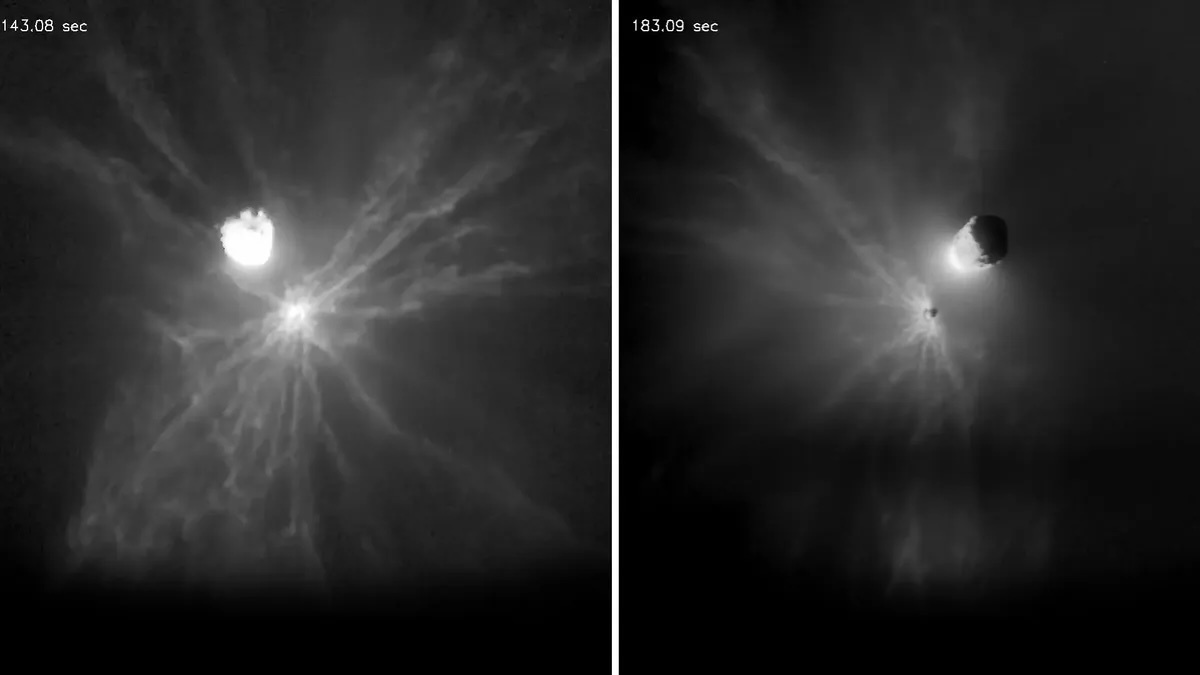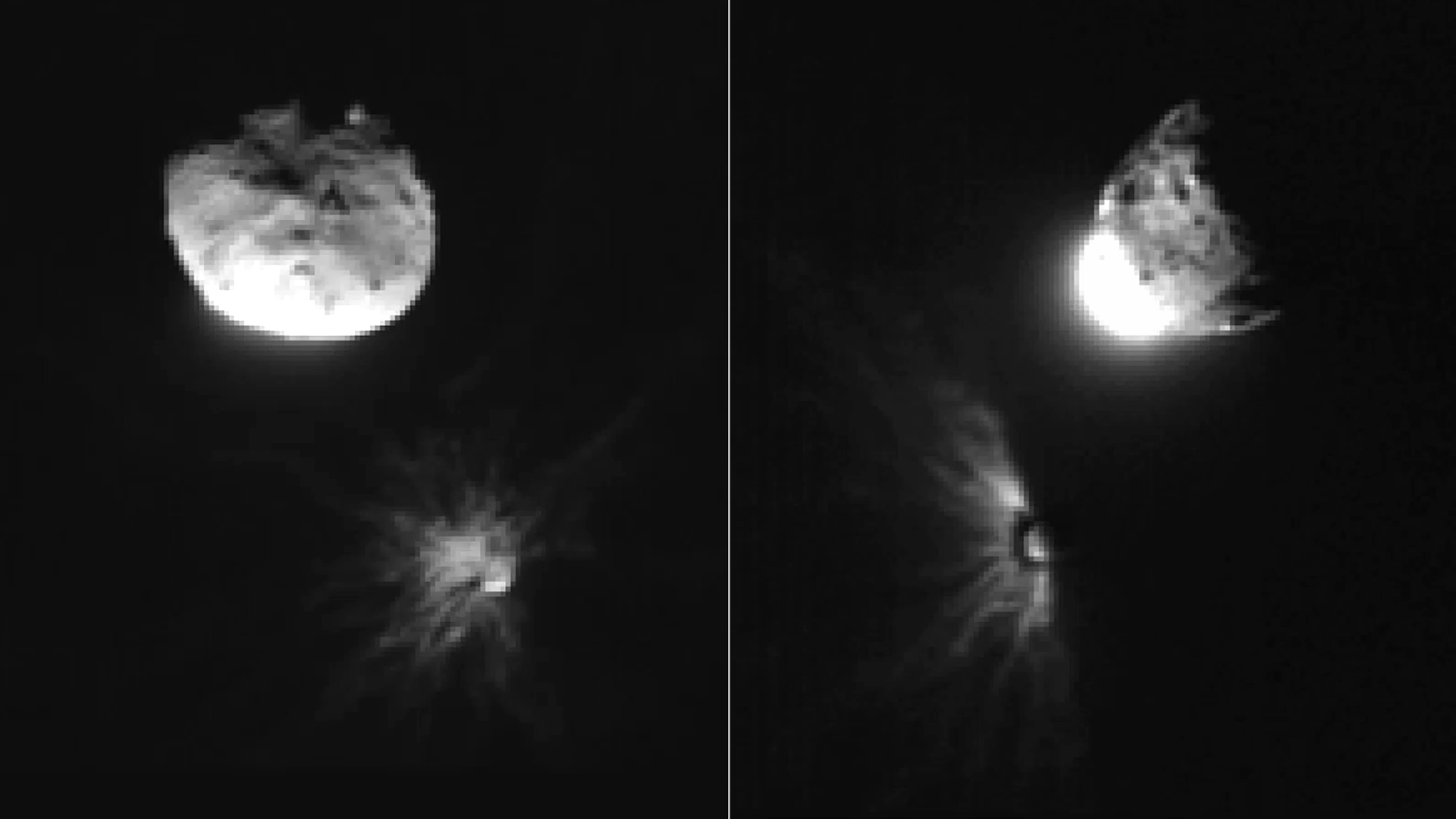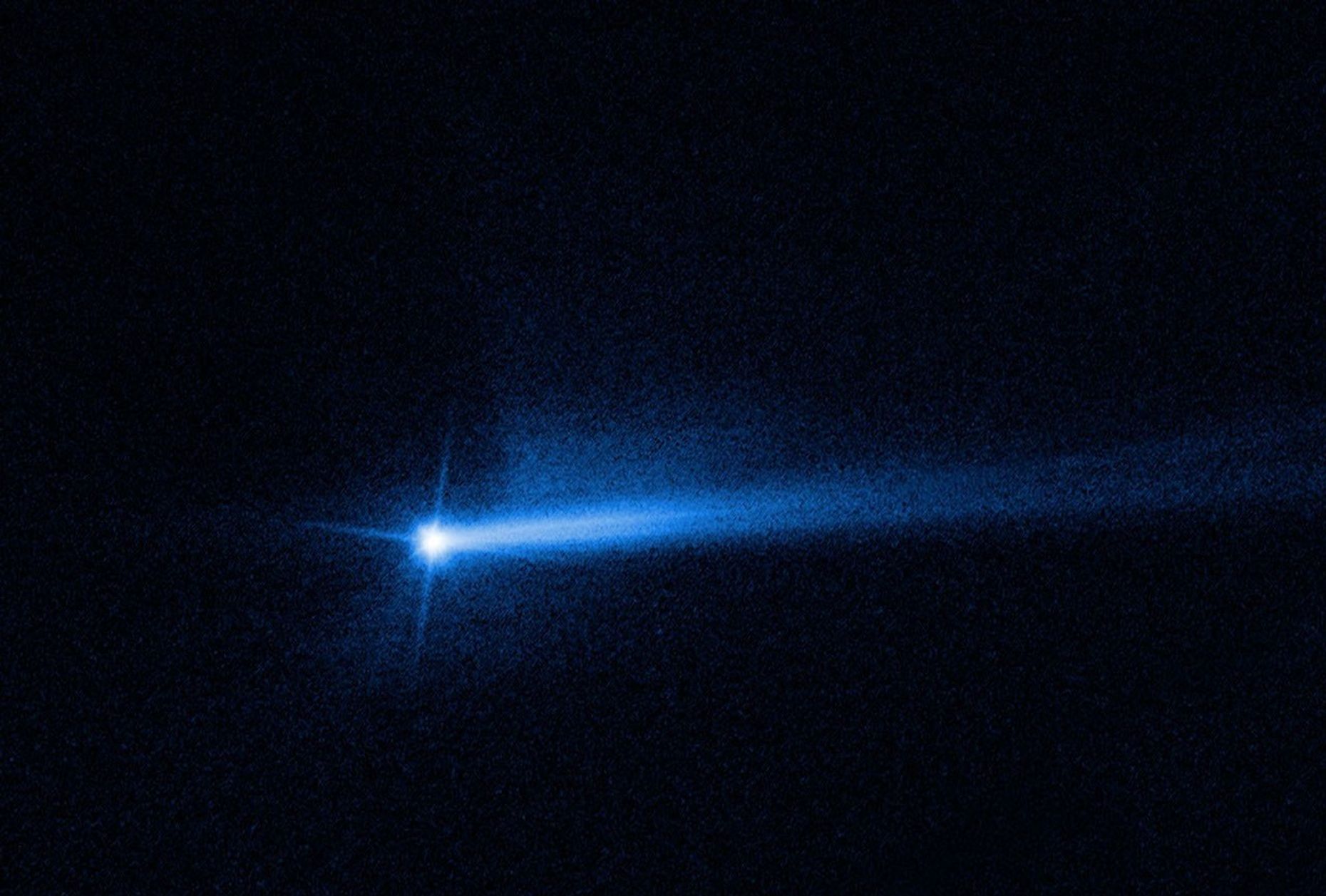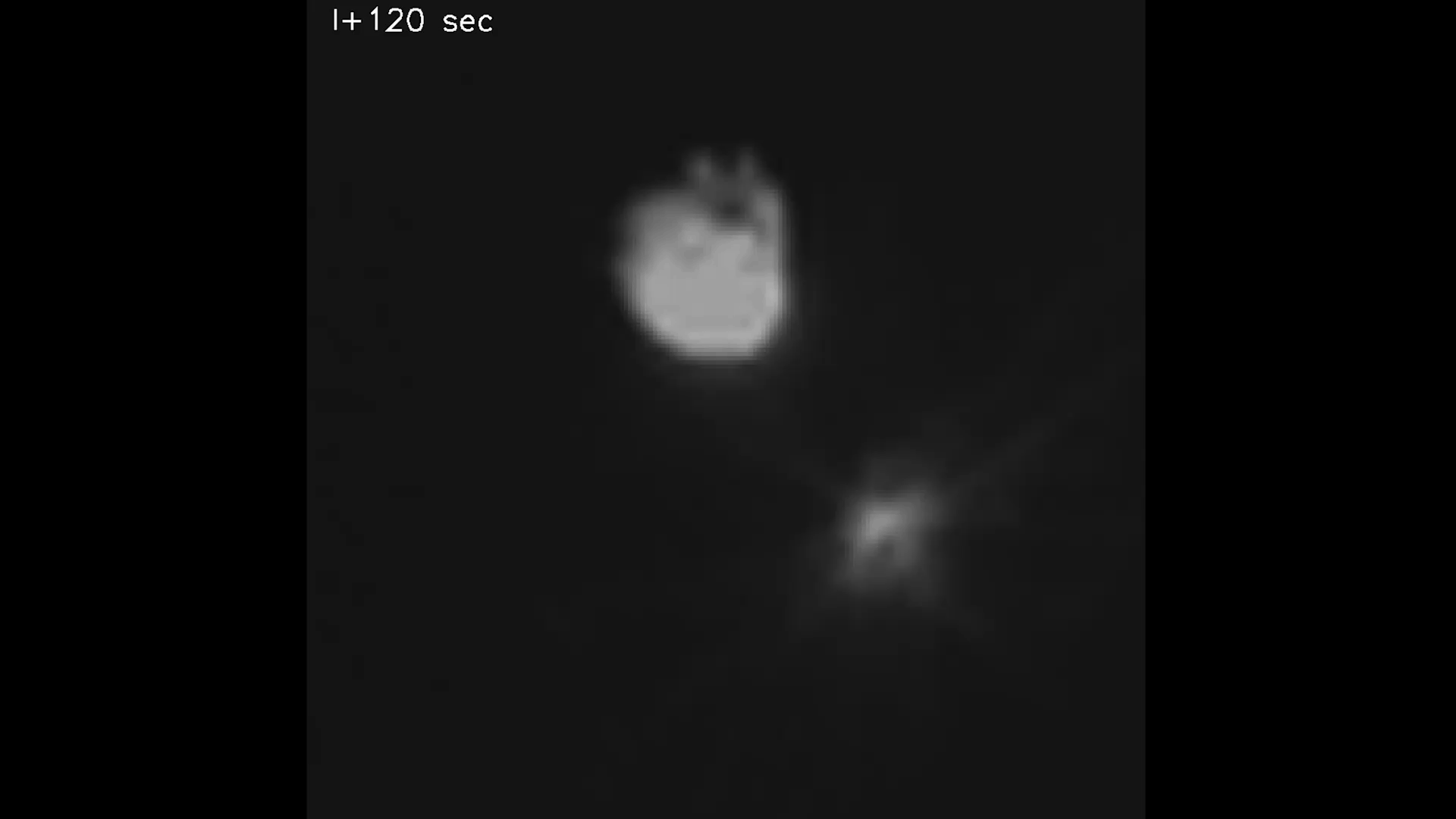11.07.2025
"You can think of it as a cosmic pool game. We might miss the pocket if we don't consider all the variables."

Images of the aftermath of the DART impact, taken just minutes after the event by LICIACube, showing ejecta from the collision. (Image credit: NASA DART Team and LICIACube
(Image credit: NASA DART Team and LICIACube)
When NASA's DART mission crashed into the asteroid Dimorphos, the first stage of the impact saw the spacecraft's solar panels strike and pulverize two large boulders on the target, debris from which spun off in two directions. That ejection created enough momentum to give Dimorphos an extra kick on top of the direct effects of the kinetic impact, according to a new analysis of the collision.
DART, the Double Asteroid Redirection Test, slammed into the 558-foot-wide (170-meter-wide) asteroid Dimorphos on Sept. 26, 2022. The force of the impact shortened Dimorphos' orbit around its larger asteroid companion, Didymos, by about 32 minutes. The point of the mission was to show that we could deflect hazardous asteroids if they're ever found to be on a collision course with Earth.
However, it now seems that there are more subtleties involved in deflecting asteroids than simple brute force.
Prior to impact, an Italian-built cubesat called LICIACube, which had piggybacked on DART, detached and took images of the immediate aftermath of the impact. As well as general clouds of dust, LICIACube saw two clusters of boulders, ranging in size from 1.3 to 23.6 feet (40 centimeters to 7.2 meters), speeding away from the point of impact. Later observations by the Hubble Space Telescope confirmed the presence of these boulders.
"We saw that the boulders weren't scattered randomly in space," Tony Farnham, an astronomer at the University of Maryland and lead author of the new research, said in a statement. "Instead, they were clustered in two pretty distinct groups, with an absence of material elsewhere, which means that something unknown is at work here."
Furthermore, these two clusters of boulders imparted more than three times the momentum imparted by the DART spacecraft.
"We succeeded in deflecting an asteroid, moving it from its orbit," said Farnham. "Our research shows that while the direct impact of the DART spacecraft caused this change, the boulders ejected gave an additional kick that was almost as big. That additional factor changes the physics we need to consider when planning these types of missions."
Twenty years ago, when NASA's Deep Impact spacecraft was deliberately sent to collide with comet 9P/Tempel, it hit a relatively smooth surface, which was reflected in a smooth and continuous ejecta sheet rather than disparate groups of large pieces of debris.
Dimorphos, in contrast to 9P/Tempel, has a rougher surface that's littered with large boulders.
Due to this, Jessica Sunshine, who is a professor of astronomy and geology at the University of Maryland and who has worked on both the Deep Impact and DART missions, thinks she knows what happened when DART hit Dimorphos.
"DART's solar panels likely hit two big boulders, called Atabaque and Bodhran, on the asteroid [in the moment before the main body of the spacecraft hit]," said Sunshine. "Evidence suggests that the southern cluster [of escaping rocks] is probably made up of fragments from Atabaque, a 3.3-meter-radius [10.8 meters] boulder."
This southern cluster contains 70% of the ejected boulders and was moving at high velocities of up to 32 miles per second (52 meters per second) at shallow angles to the surface. The ejection of the southern cluster alone could have been enough to tilt Dimorphos' orbital plane around Didymos by up to a degree.
By comparing Deep Impact with DART, it seems evident that objects with different properties to one another can react differently to being impacted. These differences will come into play should we have to deflect a dangerous asteroid or comet for real, because an error brought about by not understanding the effect of a surface on the way debris is ejected could spell disaster.
"If an asteroid was tumbling toward us, and we knew we had to move it a specific amount to prevent it from hitting Earth, then all these subtleties become very, very important," said Sunshine. "You can think of it as a cosmic pool game. We might miss the pocket if we don't consider all the variables."
To learn more, and to confirm these changes predicted by the ejection of the boulders, the European Space Agency's Hera mission will follow up on DART when it arrives at the Didymos–Dimorphos system in 2026. However, it will have to look out for boulders and other debris produced by the DART impact that could provide their own impact hazard to the spacecraft.
The new results were published on July 7 in the Planetary Science Journal.
Quelle: SC
----
Update: 23.08.2025
.
Close-Up Views of NASA’s DART Impact to Inform Planetary Defense

On Sept. 11, 2022, engineers at a flight control center in Turin, Italy, sent a radio signal into deep space. Its destination was NASA’s DART (Double Asteroid Redirection Test) spacecraft flying toward an asteroid more than 5 million miles away.
The message prompted the spacecraft to execute a series of pre-programmed commands that caused a small, shoebox-sized satellite contributed by the Italian Space Agency (ASI), called LICIACube, to detach from DART.
Fifteen days later, when DART’s journey ended in an intentional head-on collision with near-Earth asteroid Dimorphos, LICIACube flew past the asteroid to snap a series of photos, providing researchers with the only on-site observations of the world’s first demonstration of an asteroid deflection.
After analyzing LICIACube’s images, NASA and ASI scientists report on Aug. 21 in the Planetary Science Journal that an estimated 35.3 million pounds (16 million kilograms) of dust and rocks spewed from the asteroid as a result of the crash, refining previous estimates that were based on data from ground and space-based observations.
While the debris shed from the asteroid amounted to less than 0.5% of its total mass, it was still 30,000 times greater than the mass of the spacecraft. The impact of the debris on Dimorphos’ trajectory was dramatic: shortly after the collision, the DART team determined that the flying rubble gave Dimorphos a shove several times stronger than the hit from the spacecraft itself.
“The plume of material released from the asteroid was like a short burst from a rocket engine,” said Ramin Lolachi, a research scientist who led the study from NASA’s Goddard Space Flight Center in Greenbelt, Maryland.
The important takeaway from the DART mission is that a small, lightweight spacecraft can dramatically alter the path of an asteroid of similar size and composition to Dimorphos, which is a “rubble-pile” asteroid — or a loose, porous collection of rocky material bound together weakly by gravity.
“We expect that a lot of near-Earth asteroids have a similar structure to Dimorphos,” said Dave Glenar, a planetary scientist at the University of Maryland, Baltimore County, who participated in the study. “So, this extra push from the debris plume is critical to consider when building future spacecraft to deflect asteroids from Earth.”

DART’s Star Witness
NASA chose Dimorphos, which poses no threat to Earth, as the mission target due to its relationship with another, larger asteroid named Didymos. Dimorphos orbits Didymos in a binary asteroid system, much like the Moon orbits Earth. Critically, the pair’s position relative to Earth allowed astronomers to measure the duration of the moonlet’s orbit before and after the collision.
Ground and space-based observations revealed that DART shortened Dimorphos’ orbit by 33 minutes. But these long-range observations, made from 6.8 million miles (10.9 million kilometers) away, were too distant to support a detailed study of the impact debris. That was LICIACube’s job.
After DART’s impact, LICIACube had just 60 seconds to make its most critical observations. Barreling past the asteroid at 15,000 miles (21,140 kilometers) per hour, the spacecraft took a snapshot of the debris roughly once every three seconds. Its closest image was taken just 53 miles (85.3 km) from Dimorphos’ surface.
The short distance between LICIACube and Dimorphos provided a unique advantage, allowing the cubesat to capture detailed images of the dusty debris from multiple angles.
The research team studied a series of 18 LICIAcube images. The first images in the sequence showed LICIACube’s head-on approach. From this angle, the plume was brightly illuminated by direct sunlight. As the spacecraft glided past the asteroid, its camera pivoted to keep the plume in view.

As LICIACube looked back at the asteroid, sunlight filtered through the dense cloud of debris, and the plume’s brightness faded. This suggested the plume was made of mostly large particles — about a millimeter or more across — which reflect less light than tiny dust grains.
Since the innermost parts of the plume were so thick with debris that they were completely opaque, the scientists used models to estimate the number of particles that were hidden from view. Data from other rubble-pile asteroids, including pieces of Bennu delivered to Earth in 2023 by NASA’s OSIRIS-REx spacecraft, and laboratory experiments helped refine the estimate.
“We estimated that this hidden material accounted for almost 45% of the plume’s total mass,” said Timothy Stubbs, a planetary scientist at NASA Goddard who was involved with the study.
While DART showed that a high-speed collision with a spacecraft can change an asteroid’s trajectory, Stubbs and his colleagues note that different asteroid types, such as those made of stronger, more tightly packed material, might respond differently to a DART-like impact. “Every time we interact with an asteroid, we find something that surprises us, so there’s a lot more work to do,” said Stubbs. “But DART is a big step forward for planetary defense.”
Quelle: NASA
